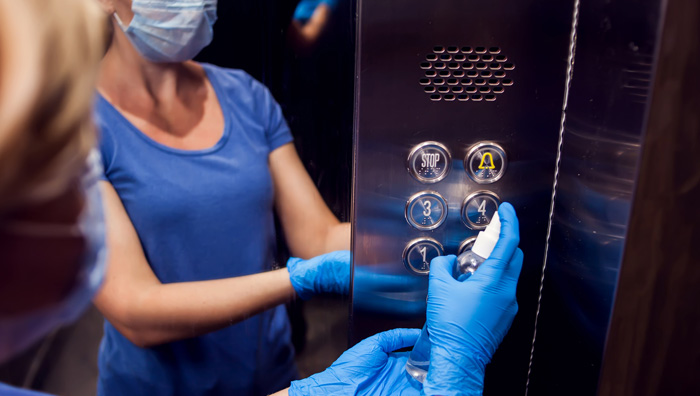Especially in light of the latest coronavirus concerns, more and more property owners are cognizant of keeping their elevators safe, clean and sanitized. It’s vital now more than ever to clean and sanitize all your public spaces, especially within elevators. Viruses such as the coronavirus and the flu spread much faster in congested, high-traffic areas used by the general public on a daily basis.

Here are some tips for sanitizing your elevators in the midst of COVID-19.
Limiting the spread of germs is imperative if you own a building with an elevator being continuously used by visitors or tenants.
- Wipe down all elevator buttons regularly with wipes or disinfectant spray on a clean, lint-free rag. Don’t spray the buttons directly.
- Wipe down all handrails and walls.
- Sweep the sills to remove dust and debris that can harbor germs and harm the operation of your elevator doors.
- Clean the tracks.
- Post signage about social distancing, instructing visitors to keep hands away from their faces and to wash their hands thoroughly.
- Install hand sanitizing stations to the side of your elevators.
- Clean walls, doors, ceilings and mirrors frequently.
- Do not use sponges because they are breeding grounds for bacteria; plus, excessive moisture can damage the electronic components.
- Don’t use bleach-based solutions because they will react negatively with polycarbonate fixtures.
Cleaning Light Fixtures and Panel Buttons
The last things you should clean on your elevator are the light fixtures and control panel buttons. First, lock the elevator so it doesn’t respond to accidental button presses. Using an antibacterial cleaning agent and microfiber cloth, wipe down all the elevator buttons but don’t spray directly on them. The solution can seep inside the control panel and harm the internal components. Do your best to remove all trapped dirt, dust and hair that have become lodged around the edges of the buttons. You can also use a microfiber cloth to clean dust and dirt from elevator light fixtures.
Cleaning the Floors and Mirrors
If you have carpeted floors in your elevators, use the brush attachment on your vacuum to clean them. If you have tile or steel floors, you can clean them using non-abrasive and non-corrosive cleaners.
Areas of Risk
When considering which cleaning tasks take priority, keep in mind High Risk Areas, which include:
- Call buttons
- Floor buttons
- Fan switch
- Door open and door close buttons
- Handles on door
- Lift floor
Doors and inside walls are considered Medium Risk, and ceilings are considered Low Risk.
Coronavirus Persistence
Here is how long coronavirus can live on various surfaces:
- Aluminum: 2 to 8 hours
- Paper: 3 hours to 4 days
- Steel: 2 to 4 days
- Plastic 2 to 6 days
- Wood: 4 days
- Glass: 5 days
- Ceramic: 5 days
Contact Mowrey Elevators
For more cleaning tips or to schedule a repair, contact us today!
